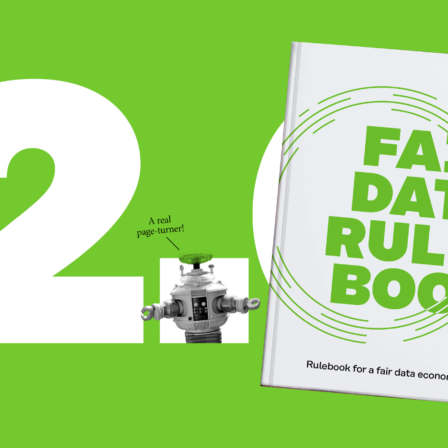The use of data in business is a hot potato at the moment. Many companies have come to realise that they have accumulated large amounts of data, but the business benefits they derive from the data are nowhere near optimal. As part of my work, I have been involved in leading digital and data-driven business activities in many different organisations. I have noticed that Finnish companies often do a good job with the technical implementation – in this case, the collection and storage of data – but they do not perform as well when it comes to commercialising data.
So, what steps do companies need to take to create new business from data?
There are at least four different paths available to companies, each representing a different level of ambition. The key for management is to decide how radically they want to reform and challenge the company’s business.
1. Improving the existing business
This is the path with the lowest level of ambition. For example, a company can continue to offer its existing products to its current customers and additionally offer data or insights that facilitate their decision-making or optimise their operations. A company can also look for familiar operators in their existing market and value chain to start data co-operation with. This path keeps the company within its existing market definition while introducing data as an element of its existing business. The change in the business model is minor.
2. A new business model alongside the existing model
With this path, a company aims to build new data business that becomes a “second pillar” for its core business. The company creates a revenue model for data and charges fees from customers for its data-related services (such as files, reports, data tables and platforms). Whereas the first path involves the company improving its existing business, this path sees it build something new. However, this path still has the company stay within its familiar market definition, which means that it continues to serve its current customers or similar customers. The outcome is new data-driven business.
3. A new position in the existing value chain
On this path, a company challenges its market specification. For example, a company can move from the role of manufacturer to the role of service provider by making use of data such as high-quality customer analysis. A company can also become a technology leader in its industry and start to provide data and algorithm products to other operators. It is typical of this path that companies use new business models to compete against new rivals. For example, companies may try to displace an existing service provider by introducing new data-driven services. The outcome is that the company will be likely to appear very different to outsiders compared to the starting point.
4. A leap into a new value chain or industry
The most radical of the four paths sees a company completely do away with its existing market definition and seek entirely new market opportunities with the help of data. For example, a telephone operator could expand its business to provide banking services, a car maker could start selling car insurance, or a company that previously focused on the Finnish market could create a new international path of growth. These new business models are underpinned by data: the better a company understands its customers, the bigger its opportunity to radically challenge its existing operations and create completely new value. The adoption of these models typically involves redefining the customer relationship, product, service or market position – or all of these at the same time.
Naturally, the categorisation of moves towards data-driven business is not always as clear-cut as is shown above. What could be seen as an interesting new idea by one company could be seen as a radical new move by another. Beauty is in the eye of the beholder. There is no need to get bogged down in categorisations.
What is more important is creating the most effective path for your company – one that takes into account customer needs, the competitive landscape and the market outlook.
It should also be noted that none of the above categories are superior to the others as a rule. A less radical and ambitious path may be the smart choice if it works for you and makes money.
Data-driven business models accelerate growth
Regardless of which path a company chooses, it is clear that new data-driven businesses hold significant commercial potential. They can enable a company to shift from linear growth (for example, through recruitment or one-off acquisitions) to fast and exponential growth, often in a way that also involves targeting the international markets. The advantages of data-driven business models include their stability, scalability and continuity, which are important features of monthly licensing models, and the use of digital distribution for data services, for example.
Investors typically value companies that have been able to create a unique source of data collection and have established a monopolistic position as a provider of various data services. International examples of such companies include Facebook, Google and Amazon.
Co-operation carries you through crises
Few companies can prosper alone. Would it be smarter to make use of partners who provide data, serve as sales and distribution channels or bring in the necessary competences, for example? The network effect can be very strong in data-driven business models. Your company’s partners are probably already thinking about how to use their data, so this could be the right time to start discussing co-operation.
In these turbulent and challenging times, creating new business from data can be an essential way for a company to build resilience that helps it recover from the demand-and-supply shocks that challenge its existing business. In many companies, data is still an asset that is not commercially utilised to a significant extent. With this in mind, building stronger competences around the commercialisation of data should be on every company’s agenda at this time.
Sitra’s guest blogs give a voice to the players of the future in different fields. They do not necessarily directly link to Sitra’s work or agenda, but are the authors’ thoughts on current issues that relate to the themes Sitra is passionate about.
The author of this blog, Mika Ruokonen, Business Director at Futurice, has sparred with the SMEs participating in Sitra’s IHAN business programme on the creation of business models in line with the principles of a fair data economy Fair data economy The part of the economy that focuses on creating services and data-based products in an ethical manner. Fairness means that the rights of individuals are protected and the needs of all stakeholders are taken into account in a data economy. Open term page Fair data economy .

















Recommended
Have some more.